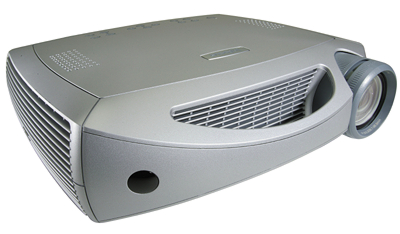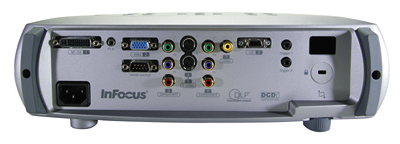InFocus ScreenPlay 7210 DLP Projector

The Ins and Outs
The InFocus ScreenPlay 7210 ($6995) is a single-chip DLP projector designed for home theater use. For a company that made its mark with projectors aimed squarely at the education and business markets, expansion into home theater hasn't been without a few minor missteps (read Steven Stone's June 2003 review of the InFocus 7200 (http://www.guidetohometheater.com/videoprojectors/129/index.html ), but those growing pains are long gone. The 7210 is a third generation product that, at least for the foreseeable future, will coexist with the $4995 second generation ScreenPlay 7205.
The 7210 costs more, but also gives you more for the money. While sporting the same hi-def capable 1280 x 720 mirror farm of the 7205, the newer projector sports Texas Instruments' latest effort to achieve better blacks: the HD2+ DarkChip3 Digital Micromirror Device (DMD).
Unlike the SIM2 Grand Cinema HT300 E-LINK I reviewed recently, which used a separate video switcher/processor tethered to the projector by a single 50-foot cable, all the InFocus video inputs are on the back panel of the projector itself. The SIM2 was easy to hook up. The InFocus, on the other hand, might not be, depending on what you have in your front end for sources. In fairness, nearly all affordable DLP and LCD projectors, are single box devices that invite compromise. Depending on your system, you may need to run lots of cable.
The projector offers two sets of component inputs, each capable of accepting standard or hi-definition sources. Two s-video and a single composite input round out the more conventional and low-grade end of things. There are also three unconventional inputs on the 7210. The first is a DVI/HDCP-compatible M1-DA input that looks somewhat like a DVI connection on steroids. Short adapter cables provided with the projector let you connect either a DVI-D or 21-pin SCART (Euro-connector) cable to the M1-DA. A 15-pin VESA input, appropriate for a computer or video game, and a D5 video input complete the available inputs.
Many of the controls of the remote are duplicated on the projector's top panel, though they're not really needed. Years of building projectors for the PowerPoint crowd has taught InFocus to put things in close reach, but when you consider that a home theater projector is likely to be permanently mounted, the extra controls are superfluous for the most part.
The 7210's remote is a honey. It's small, light and easy to use. A button on the side activates a soft, orange backlighting that illuminates the text or graphic on each button and is easy on the eyes in a darkened theater room.
Hunting through the excellent (if too abbreviated) user manual I found how to reprogram what appeared at first to be simply a video "mute" button (press and the picture goes black) into a button that projected a test grid on the screen, perfect for setting the zoom and focus. If reading manuals isn't your cup of tea, there's also an excellent self-paced online presentation on InFocus's web site that explores most aspects of the system ( http://www.infocushome.com/amer/eng/products/ScreenPlay/sp7210.asp). InFocus also has other online resources to help you calculate screen size, throw distance and expected image brightness in foot-lamberts.
The projector can be leveled and aimed via two soft feet in the back (one fixed and one height-adjustable) and a drop down "leg" in the front that uses a quick release mechanism accessible from the side. There is no mechanical lens shift, but you have some leeway with the 7210. The bottom of the image (assuming a table mount) will be 0.16 times the screen height above the horizontal axis of the lens. In my case, with a 78" wide by 44" tall screen, the projector should be 7" below the bottom of the screen. In reality, I just plopped the projector in the only place that seemed to make sense and got lucky. Image geometry was perfect in my setup.
Getup and Setup
Going into the menus, the 7210 is easy to setup and adjust. In the advanced menu, you can select among three different color temperatures, 6500K, 7500K and 9300K. No need to tell anyone here what setting I selected (I hope), but the industry standard 6500K setting looked very good to my eyes. For calibration, another menu gives you access to both red, green and blue drive and offset controls which, like the brightness and contrast, are on a 100 point scale.
The projector's gamma curve settings contain several useful preset modes. I focused on three of them: Video, Cinema, and CRT. Switching between them was easily accomplished with the remote. I spoke with Brian Carskadon of InFocus and he confirmed what my eyes told me: with my Stewart Studiotek 130 screen (1.3 gain, white) the CRT gamma curve would be the best for film-based DVD material. While not as bright as either Video or Cinema, it offered greater black level detail and less white peaking.
The throw distance of the projector forced its placement on the end table between my two viewing chairs. With a multi-speed fan, the 7210 is not the quietest of projectors, though a ceiling mount would certainly have moved the noise further from the viewer. Besides the noise consideration, there's the matter of the "cook an egg" heat wave being blown out the unit's right side along with a modicum of light leakage. Things were much better to the unit's left side, so everyone around here got used to calling "shotgun" for that seat. But even the left side had a small amount of light spill. So for a triad of reasons – noise, heat, and light – the Infocus 7210 should make friends with your ceiling, not your coffee table.

As mentioned, the 7210 has no mechanical lens shift, so proper installation planning is critical. While the projector has them, you should avoid using digital keystone correction at all costs. What you really get with digital keystone adjustment, effectively, is reduced picture resolution. Everyone make the sign of the cross with their index fingers and back away from the controls.
While recent LCD projectors from Sony and Panasonic use automatic iris controls to increase the contrast ratio of their projectors, the 7210 lacks this feature. One could argue that DLP projectors, by virtue of their already superior contrast measurements, have no need for such confections. While that is valid in relative terms, in absolute terms iris controls might help further improve shadow detail. [To date, only one single-chip DLP projector on the market is said to offer this feature—the BenQ 8720- Ed.]
- Log in or register to post comments




































































